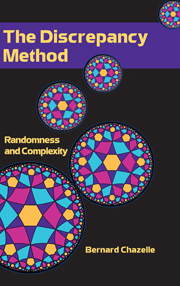Book contents
- Frontmatter
- Contents
- Preface
- 1 Combinatorial Discrepancy
- 2 Upper Bound Techniques
- 3 Lower Bound Techniques
- 4 Sampling
- 5 Geometric Searching
- 6 Complexity Lower Bounds
- 7 Convex Hulls and Voronoi Diagrams
- 8 Linear Programming and Extensions
- 9 Pseudorandomness
- 10 Communication Complexity
- 11 Minimum Spanning Trees
- A Probability Theory
- B Harmonic Analysis
- C Convex Geometry
- Bibliography
- Index
6 - Complexity Lower Bounds
Published online by Cambridge University Press: 05 October 2013
- Frontmatter
- Contents
- Preface
- 1 Combinatorial Discrepancy
- 2 Upper Bound Techniques
- 3 Lower Bound Techniques
- 4 Sampling
- 5 Geometric Searching
- 6 Complexity Lower Bounds
- 7 Convex Hulls and Voronoi Diagrams
- 8 Linear Programming and Extensions
- 9 Pseudorandomness
- 10 Communication Complexity
- 11 Minimum Spanning Trees
- A Probability Theory
- B Harmonic Analysis
- C Convex Geometry
- Bibliography
- Index
Summary
The discrepancy method is not just about designing algorithms. Techniques used for showing the necessity of disorder in complex structures can sometimes be recycled to prove the computational difficulty of solving certain problems. In this case, our aim is to translate high discrepancy into high complexity. To add a touch of irony, we will occasionally run into lower bound arguments that need highly uniform structures as auxiliary devices. So, expect low discrepancy to be part of the picture as well.
The arguments developed in this chapter are almost exclusively algebraic or Ramsey-type. The problems that they are trying to solve arise in the context of arithmetic circuits and geometric databases. They are all variations on the same “matrix complexity” theme: Let A be an n-by-n matrix with 0/1 elements. The goal is to assemble the matrix A by forming a sequence of column vectors U1, …, Us ∈ Zn, where s ≥ n and
(U1, …, Un) is the n-by-n identity matrix;
A = (Us−n+1, …, Us);
for any i = n + 1, …, s, there exist j, k < i and αi, βi ∈ Z such that Ui, = αiUj + βiUk.
The minimum length s of any sequence that satisfies these three conditions is called the complexity of A. We leave the following statements as warm-up exercises: All 0/1 matrices have complexity O(n2).
Information
- Type
- Chapter
- Information
- The Discrepancy MethodRandomness and Complexity, pp. 228 - 282Publisher: Cambridge University PressPrint publication year: 2000
